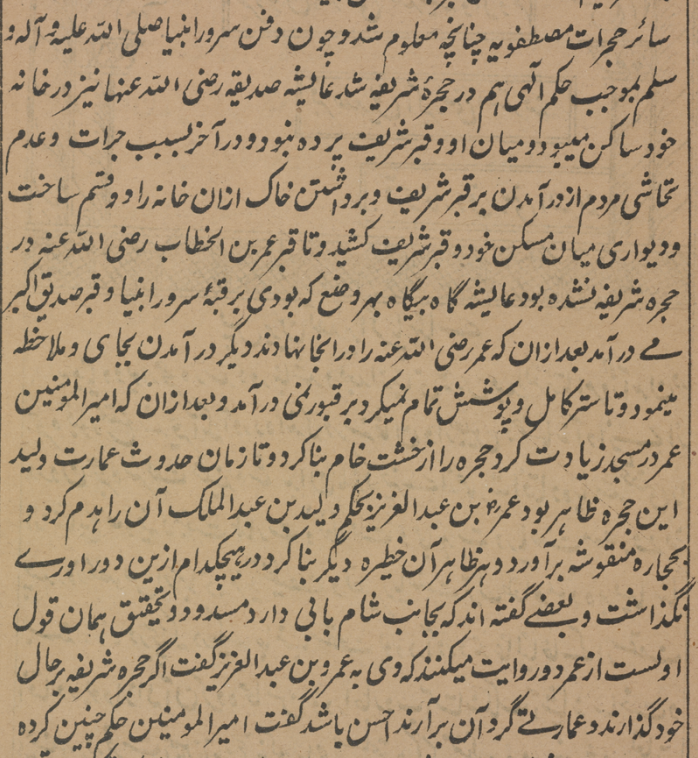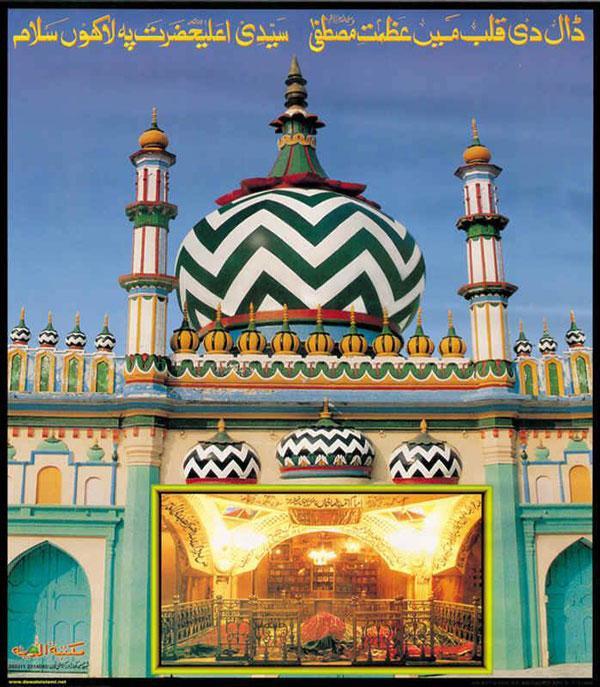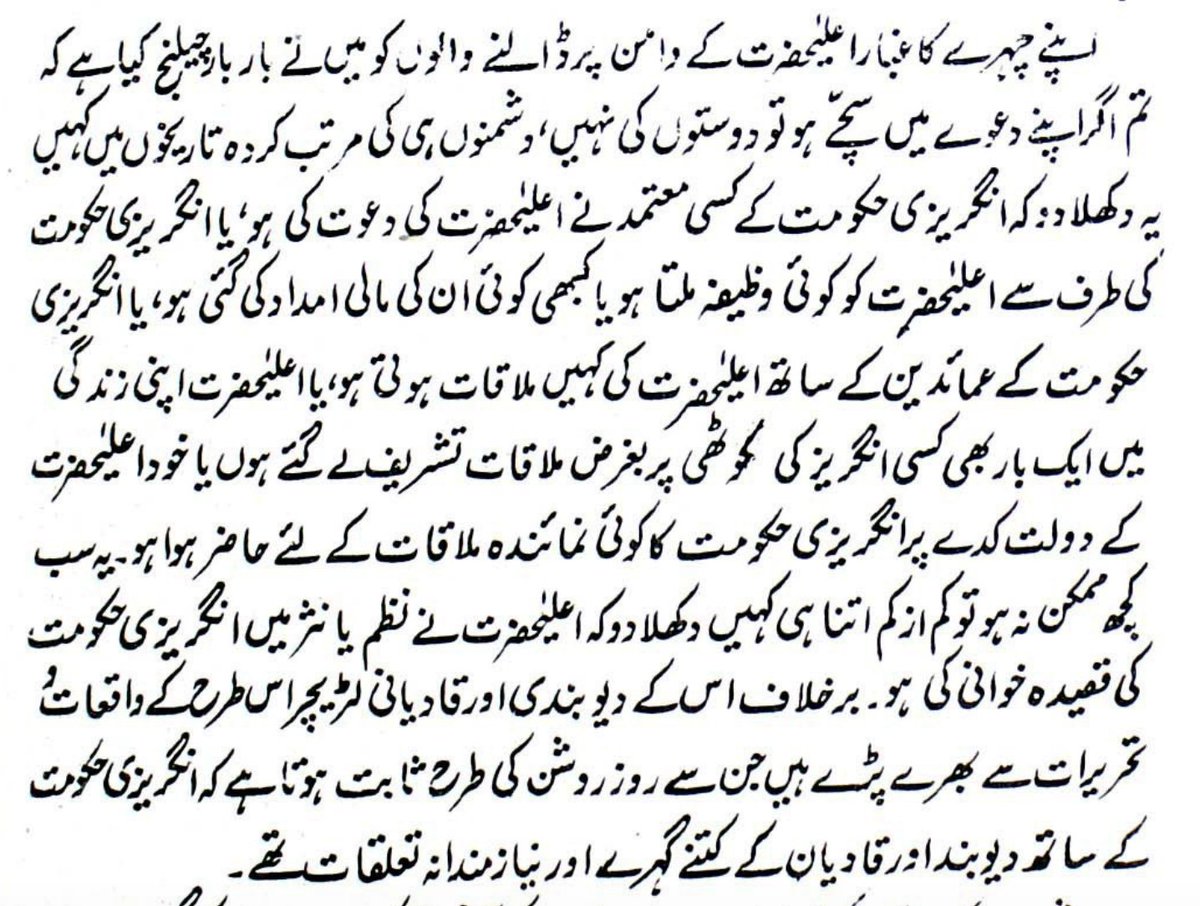
PERMISSIBILITY OF BUILDING AROUND THE GRAVES OF THE RIGHTEOUS
Alahazrat Imām Aĥmad Riđā Khān al-Ĥanafī al-Baraylawī [1272-1340 AH / 1856-1921 CE] wrote, as recorded in Fatāwā al-Riđawiyyah:
❝The Ayimmah e Dīn [Imāms of the religion] held it permissible to construct a building


Alahazrat Imām Aĥmad Riđā Khān al-Ĥanafī al-Baraylawī [1272-1340 AH / 1856-1921 CE] wrote, as recorded in Fatāwā al-Riđawiyyah:
❝The Ayimmah e Dīn [Imāms of the religion] held it permissible to construct a building
https://twitter.com/IbnEbida/status/1330943736981970947



around the mazārāt [graves] of the respected Úlamā’a and Mashāyikh قدست اسرارهم (may Allāh sanctify their secrets) on land with permissible disposal, with the purpose that visitors and beneficiaries may find rest [in them]. They made clear that the reason behind the prohibition
is [when there is] an evil intention or absence of benefit, thus where there is a praiseworthy intention and benefit is present, then the prohibition falls away. Analysis of circumstances and noble research in this matter is that if the building is built first and then burial
takes place in it afterwards, then the matter is not even related to binā’a ála’l qabr [building over the grave], as this is iqbār fī’l binā’a [making a grave in a building], not binā’a ála’l qabr.
Állāmah Ţarābulsī in Burhān Sharĥ Mawāhibu’r Raĥmān, then Állāmah
Állāmah Ţarābulsī in Burhān Sharĥ Mawāhibu’r Raĥmān, then Állāmah
Shurunbulālī in Ghunyah dhawi’l Aĥkām, then Állāmah Sayyid Abu’s Súūd Azharī in Fatĥullāh al-Muýīn, then Állāmah Sayyid Aĥmad Mişrī in the Ĥāshiyah of Durr [al-Mukhtār] and Ĥāshiyah of Marāqi’l Falāĥ state, and the wording is that of Ghunyah:
❛It is said in Burhān that it is
❛It is said in Burhān that it is

Ĥārām to build over it for embellishment. It is disliked to do so after burial in order to consolidate it, burial in a place built beforehand is not [disliked] due to the absence of it being a grave in reality without it [i.e. the burial].❜
And if it is built after the burial,
And if it is built after the burial,
then there are two cases of this:
1. The first is this that a building is constructed upon the grave itself. There is no doubt regarding the prohibition of this, as the roof of the grave and the space of the grave is the right of the deceased, alongside this there is
1. The first is this that a building is constructed upon the grave itself. There is no doubt regarding the prohibition of this, as the roof of the grave and the space of the grave is the right of the deceased, alongside this there is
humiliation and harm to him in this. To the extent that sitting and walking on the grave was made prohibited, then what of erecting a building upon it?
Many of the Úlama’a of our Madh’hab قدست اسرارهم took this meaning from the Aĥādīth and narrations of prohibiting building, and
Many of the Úlama’a of our Madh’hab قدست اسرارهم took this meaning from the Aĥādīth and narrations of prohibiting building, and
in fact this is the real meaning of binā’a ála’l qabr. To construct a building around the grave is ĥawl al-qabr [around the grave], not ála’l qabr [upon the grave].
Just as the prohibition of Şalāt ála’l qabr [praying upon the grave] does not include bijanb al-qabr [by the side
Just as the prohibition of Şalāt ála’l qabr [praying upon the grave] does not include bijanb al-qabr [by the side
of the grave], as the Úlama’a have made clear and we have explained in our fatāwā.
Imām Faqīhu’n Nafs Fakhru’l Millah wa’d Dīn Uzjandī states in Khāniyyah:
❛The grave should not be plastered due to what was narrated from Nabī ﷺ that he forbade plastering with mortar and lime,



Imām Faqīhu’n Nafs Fakhru’l Millah wa’d Dīn Uzjandī states in Khāniyyah:
❛The grave should not be plastered due to what was narrated from Nabī ﷺ that he forbade plastering with mortar and lime,




and building upon the grave. They [the Úlama’a] said that by building it is meant that safţ [structure] which is made upon the grave in our region, due to what was narrated from Imām Abū Ĥanīfah that he said the grave should not be plastered with mortar and cement, and nor should
there be a building or safţ raised upon it.❜
Imām Ţāhir bin Ábdu’l Rashīd Bukhārī states in Khulāşah:
❛A building should not be raised upon it. They [the Úlama’a] said that by building it is meant that safţ [structure] which is made upon the graves in our region. It has been
Imām Ţāhir bin Ábdu’l Rashīd Bukhārī states in Khulāşah:
❛A building should not be raised upon it. They [the Úlama’a] said that by building it is meant that safţ [structure] which is made upon the graves in our region. It has been

said in the fatāwā that in this age they have exceeded in safţs.❜
In Raĥmāniyyah from Nişāb al-Iĥtisāb:
❛It is not permissible for anyone to build upon graves a house or a Masjid because the place of the grave is the right of the buried one. Thus, it is not permissible for

In Raĥmāniyyah from Nişāb al-Iĥtisāb:
❛It is not permissible for anyone to build upon graves a house or a Masjid because the place of the grave is the right of the buried one. Thus, it is not permissible for


anyone to dispose with the area of his grave.❜
It is in Hindiyyah:
❛One sins by treading upon the graves because the roof of the grave is the right of the deceased.❜
2. The second is that a terrace or a building is constructed around the grave. If this is in land that is

It is in Hindiyyah:
❛One sins by treading upon the graves because the roof of the grave is the right of the deceased.❜
2. The second is that a terrace or a building is constructed around the grave. If this is in land that is


impermissible to dispose of, such as that in the possession of another person without permission of the owner or land that is waqf without the condition of the wāqif, then for this reason it is impermissible as in such a place to even construct a masjid is impermissible, then
what of a building? For this reason it is transmitted in Mirqāt from Azhār:
❛The prohibition is due to impermissibility in the waqfī graveyard, and it is necessary to destroy it even if it be a masjid.❜
Likewise, if it is done with a corrupt intention such as embellishment

❛The prohibition is due to impermissibility in the waqfī graveyard, and it is necessary to destroy it even if it be a masjid.❜
Likewise, if it is done with a corrupt intention such as embellishment


and boasting as with the graves of rulers, lofty buildings are built on them with large expenditure for this purpose, then this is prohibited due to corrupt intention, as has been mentioned from Burhān, and similar to it in Nūru’l Īđāĥ and others.
Similarly, where it is without
Similarly, where it is without
benefit, such as a grave is located in a jungle where people do not pass by, or the graves of the common people who are not righteous that nobody has attachment to go to their graves for excellence of tabarruk and deriving benefit, nor expectation of their living heirs that they
will go and sit for the purpose of visiting the grave and conferring benefits to the deceased in winter, summer, rain, and various seasons. That they will remain busy in Qur’ān and dhikr or that they will appoint, in a permissible manner, reciters and those who will do dhikr.
In such a case there is prohibition [of building] due to prodigality and wasting of wealth.
Állāmah Tūrpashtī states:
❛It is prohibited due to the absence of benefit in it.❜
It is in Majmá Biĥār al-Anwār:
❛It is prohibited due to the absence of benefit in it.❜



Állāmah Tūrpashtī states:
❛It is prohibited due to the absence of benefit in it.❜
It is in Majmá Biĥār al-Anwār:
❛It is prohibited due to the absence of benefit in it.❜




It is in Mirqāt:
❛Some commentators from our Úlama’a said: And due to wasting of wealth.❜
Where it is free of all these adversities, then there is no reason for its prohibition. For this reason Mawlānā Álī Qārī stated, after narrating the aforementioned words of Tūrpashtī:


❛Some commentators from our Úlama’a said: And due to wasting of wealth.❜
Where it is free of all these adversities, then there is no reason for its prohibition. For this reason Mawlānā Álī Qārī stated, after narrating the aforementioned words of Tūrpashtī:



❛I say: it is benefitted from, when the pavilion is for a benefit, such as the sitting of reciters beneath it, then it shall not be prohibited. Ibn al-Humām said: They differed regarding the sitting of reciters in order to recite by the grave, and the chosen position is that 



there is no dislike.❜
Shaykhu’l Islām states in Kashf al-Ghiţā’a:
❛If there is a correct intention then there is no harm in it, such as to construct a building near the grave for people to rest in, and to light candles in the graveyard in order to repel the difficulties of

Shaykhu’l Islām states in Kashf al-Ghiţā’a:
❛If there is a correct intention then there is no harm in it, such as to construct a building near the grave for people to rest in, and to light candles in the graveyard in order to repel the difficulties of


people due to the darkness of the path, and deeds such as this, the Úlama’a have stated. Such it is understood from the Sharĥ of the Shaykh.❜
It is in Saĥīĥ Bukhārī Sharīf:
❛From Áāyishah from Nabī ﷺ, that he said in his final illness: Allāh cursed the Jews and the
It is in Saĥīĥ Bukhārī Sharīf:
❛From Áāyishah from Nabī ﷺ, that he said in his final illness: Allāh cursed the Jews and the
Christians, they took the graves of their Anbiyā’a as a masjid. She said: If not for that, his grave would be kept visible.❜
Állāmah Qasţalānī writes under the aforementioned Ĥadīth in Irshādu’s Sārī:
❛However, they did not keep it visible, that is, they did not keep it open,

Állāmah Qasţalānī writes under the aforementioned Ĥadīth in Irshādu’s Sārī:
❛However, they did not keep it visible, that is, they did not keep it open,


rather they built over it a partition.❜
It is in Jadhb al-Qulūb:
❛When Sarwar-i-Anbiyā [Leader of the Prophets] ﷺ was buried in the Ĥujrah-i-Sharīfah [Sacred Chamber] according to Ĥukm-i-Ilāhī [Divine Decree], Áāyishah-i-Siddīqah resided in her house, and between her and the


It is in Jadhb al-Qulūb:
❛When Sarwar-i-Anbiyā [Leader of the Prophets] ﷺ was buried in the Ĥujrah-i-Sharīfah [Sacred Chamber] according to Ĥukm-i-Ilāhī [Divine Decree], Áāyishah-i-Siddīqah resided in her house, and between her and the



Qabr-i-Sharīf there was no partition. In the end, due to the boldness and fearlessness of people coming to the Qabr-i-Sharīf and taking the dust from there, the house was divided into two and a wall was drawn between her dwelling and the Qabr-i-Sharīf. After that, when Amīru’l
Mu’minīn Úmar expanded the masjid, he built the Ĥujrah from unbaked bricks and this Ĥujrah was visible until the new building of Walīd. Úmar bin Ábdu’l Ázīz dismantled it on the command of Walīd bin Ábdu’l Malik and built it with carved stones. He built another wall on the
outer part, and did not leave anything from these two doors. There is a narration from Úrwah that he said to Úmar bin Ábdu’l Ázīz: If you left the Ĥujrah-i-Sharīfah in its condition and constructed a building around it, it would be better.❜
No doubt, the Ayimmah e Kirām have
No doubt, the Ayimmah e Kirām have
made clear the permissibility of building around the graves of Úlamā’a and Mashāyikh قدست اسرارهم.
Állāmah Ţāhir Fatnī states after the passage quoted before:
❛The Salaf permitted building over the graves of the famous Mashāyikh and Úlamā’a so that people may visit them and

Állāmah Ţāhir Fatnī states after the passage quoted before:
❛The Salaf permitted building over the graves of the famous Mashāyikh and Úlamā’a so that people may visit them and


may rest by sitting therein.❜ Similarly, Állāmah Álī Qārī Makkī mentioned the very same after the written passage:
❛The Salaf permitted building...❜
It is in Kashfu’l Ghiţā’a:
❛It is written in Maţālibu’l Mu’minīn that the Salaf held it permissible to build over the graves


❛The Salaf permitted building...❜
It is in Kashfu’l Ghiţā’a:
❛It is written in Maţālibu’l Mu’minīn that the Salaf held it permissible to build over the graves



of the famous Mashāyikh and Úlamā’a so that people may visit and may find rest by sitting therein. However, if it is built for embellishment then it is Ĥarām. In Madīnah-i-Muţahharah domes were built over the graves of the Asĥāb in the past, it is apparent that since that time
they were considered permissible and there is also a lofty dome over the Marqad-i-Munawwar of Añhazrat ﷺ.❜
It is in Nūru’l Īmān:
❛Shaykh al-Dihlawī has narrated in Madārij from Maţālibu’l Mu’minīn that the Salaf permitted building domes over the graves of the famous
It is in Nūru’l Īmān:
❛Shaykh al-Dihlawī has narrated in Madārij from Maţālibu’l Mu’minīn that the Salaf permitted building domes over the graves of the famous

Mashāyikh and Úlamā’a so that visitors may find rest and sit in their shade. Similarly in Mafātīĥ Sharĥ al-Maşābīĥ, and Ismāýīl al-Zāhidī permitted it, who is from the famous Fuqahā’a.❜
Állāmah Sayyid Ţaĥţāwī clearly stated in Ĥāshiyah e Marāqi’l Falāĥ that there is not even
Állāmah Sayyid Ţaĥţāwī clearly stated in Ĥāshiyah e Marāqi’l Falāĥ that there is not even
any dislike in this, to the extent he stated in the matter of burial in a vault:
❛In places like Qurāfah in Egypt, a Laĥd [niche] cannot be made and more than one person is buried in a grave due to necessity. As for building, then regarding this the difference has preceded, and

❛In places like Qurāfah in Egypt, a Laĥd [niche] cannot be made and more than one person is buried in a grave due to necessity. As for building, then regarding this the difference has preceded, and


mixing is due to necessity. If a barrier is made between the deceased then there is no dislike.❜
At the end is this that Imām e Ajal Abū Ábdullāh Muĥammad bin Ábdullāh Ghazzī Tumurtāshī in Tanwīru’l Abşār wa Jamiyu’l Biĥār, then Állāmah Muĥaqqiq Álāuddīn Muĥammad Dimashqī in
At the end is this that Imām e Ajal Abū Ábdullāh Muĥammad bin Ábdullāh Ghazzī Tumurtāshī in Tanwīru’l Abşār wa Jamiyu’l Biĥār, then Állāmah Muĥaqqiq Álāuddīn Muĥammad Dimashqī in
Sharĥ Tanwīr, then Fāđil e Jalīl Sayyidī Aĥmad Mişrī in Ĥāshiyah e Marāqī made clear and affirmed that the opinion of permissibility is chosen and is the muftā bih [the one upon which the fatwā is given], and these are the words of Állāmah Ghazzī:
❛A building should not be

❛A building should not be


raised over it, and it has been said that there is no harm in this, and this is the chosen position.❜❞
@threadreaderapp unroll
• • •
Missing some Tweet in this thread? You can try to
force a refresh



















